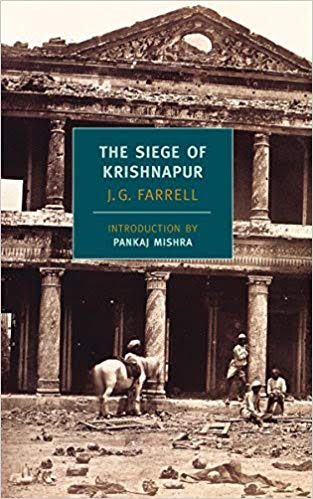"The Seige of Krishnapur" by J. G. Farrell

Above: "The Siege of Krishnapur." J. G. Farrell - 343 pages
The characters are unforgettable... there are riveting battle scenes... the novel is a page turner.
I completed reading this book today.
This book, published in 1973, won the Booker Prize. The novel is widely considered to be one of the finest British novels of the last fifty years.
I read this book anticipatory to our visit to Lucknow, India in December 2019. TIMDT read "The Siege of Krishnapur" twenty years ago.
The scene for the novel is set in India, 1857 - the year of the Great Mutiny, when Muslim soldiers turned in bloody rebellion on their British overlords. Krishnapur is a fictional Victorian outpost on the Gangetic Plain. Lucknow, India, which was actually under siege for four months during the Indian Mutiny, is Farrell's template for the fictional Krishnapur.
The British population in Krishnapur starts hearing rumors of impending strife but carries on with the traditional British "stiff upper lip..." until violence comes upon them. They retire to the Residency, local headquarters for the British East India Company, a group of close proximity buildings, where they prepare for a siege. They expect to be soon rescued by British East India company troops coming from Calcutta.
The besieged are subject to repeated attack, oppressive heat, monsoon rains, and disease over a four month period. Farrell's characters respond to these conditions in various ways. The leader for example, The Collector, is a decent man enduring the slow death of his ideals. Fleury, a young seeming literary type dandy, finds reserves of courage and bravery he didn't know he had.
Towards the later stages of the siege, when the food of the dead is auctioned off, the auctioneer has rigged the bidding so as to be the beneficiary of all of the foodstuffs being auctioned off. The priest, the Padre, becomes obsessed with sin. He believes the besieged must have done something to offend God so as to be subject to the brutalities of deteriorating life at the Residency. Dr's Dunstaple and McNab row over the best way to treat cholera. Lucy, a "fallen" woman starts a tea salon.
Farrell's picture of the British Empire in crisis raises questions about ongoing conflicts between cultures of the East and of the West. Can there be common ground where two cultures, one as a colonial conqueror, are seemingly so different? Can two such cultures coexist in one country when they both have legal footing?
By the end of the novel cholera, starvation and the sepoys have killed off most of the inhabitants, who are reduced to eating dogs, horses and finally beetles. Teeth of the survivors are much loosened by scurvy.
The final chapter of the book details the last ditch efforts of the still proper Brits to retreat through pantries, laundries, music rooms and the ball room, using chandeliers and violins as weapons.
At the last moment, just as the final sepoy attack is expected to annihilate the last Krishnapur survivors, a strange calm comes to the Residency. Hearing some movement in an adjacent room, the beleaguered besieged turn to see a young, red coated subaltern enter the room, saying, "I say, chaps, I'm here to relieve you." Such dead pan humor, in the context of tragic suffering, pervades the novel. It is indicative of Farrell's brilliant use of irony and of his deep insight into British character.
However, do not read the novel to better understand sepoy character or humor. The mutineers are like the zombies in the AMC TV series, "The Walking Dead." They are there.... they are a threat... but, none is developed as a personality. The "zombies" have their cheerleaders though. Locals, from maharajas to beggars, picnic on a river embankment where they view the progress of the siege and cheer on the sepoys. Even more ironic humor here!
The characters are unforgettable... there are riveting battle scenes... the novel is a page turner.
Note: December 2019 India trip will include another destination of historic British and Indian conflict: Amritsar, site of the horrific, tragic Jillianwala Bagh massacre, one hundred years ago.